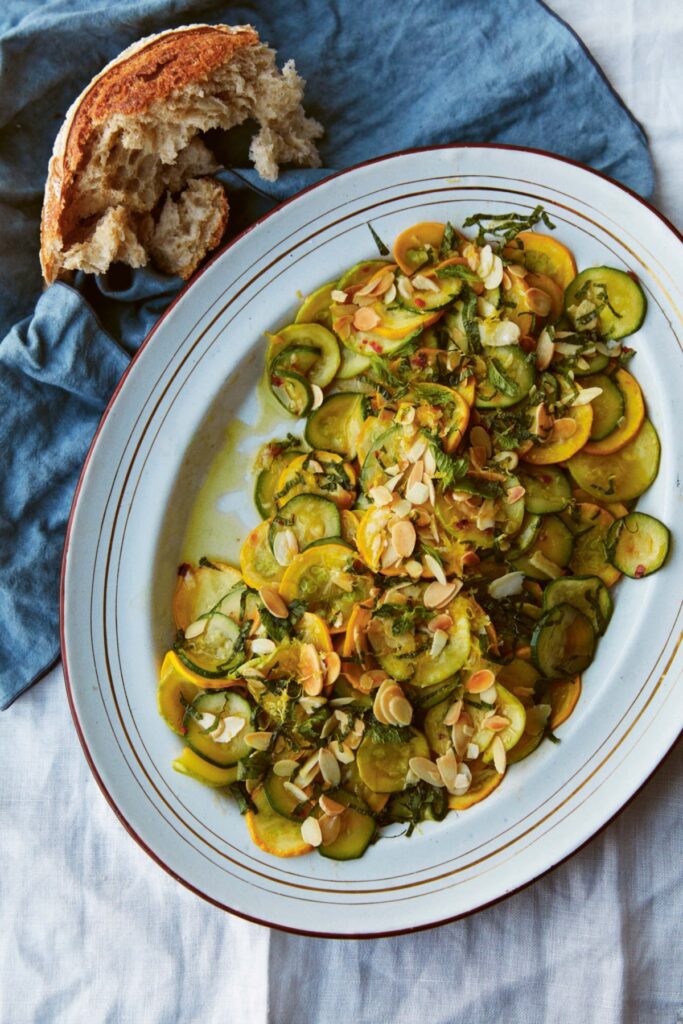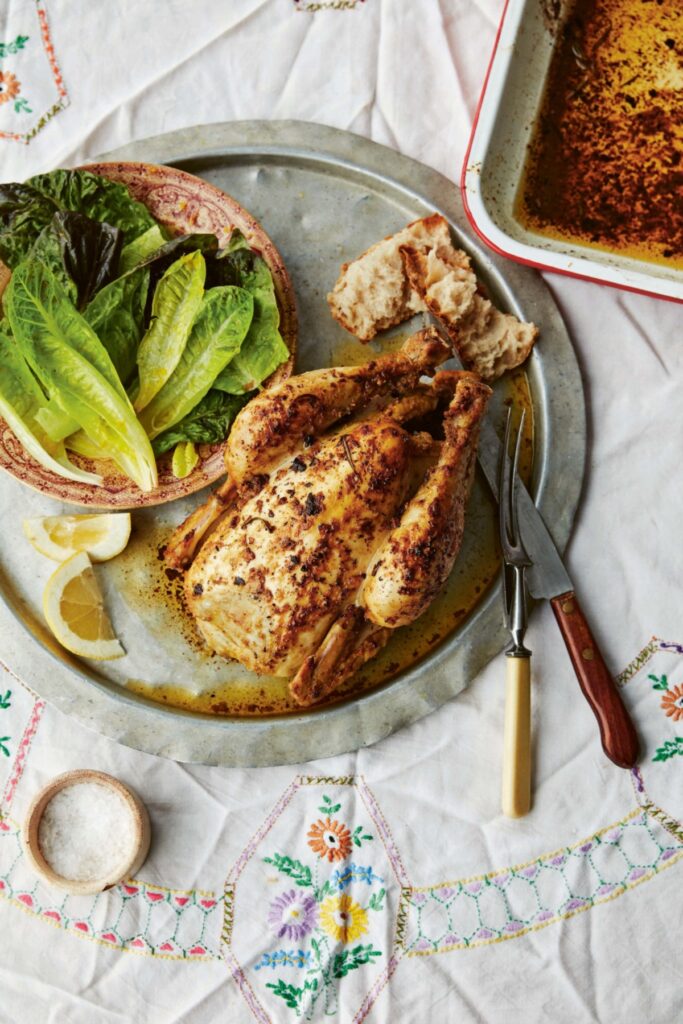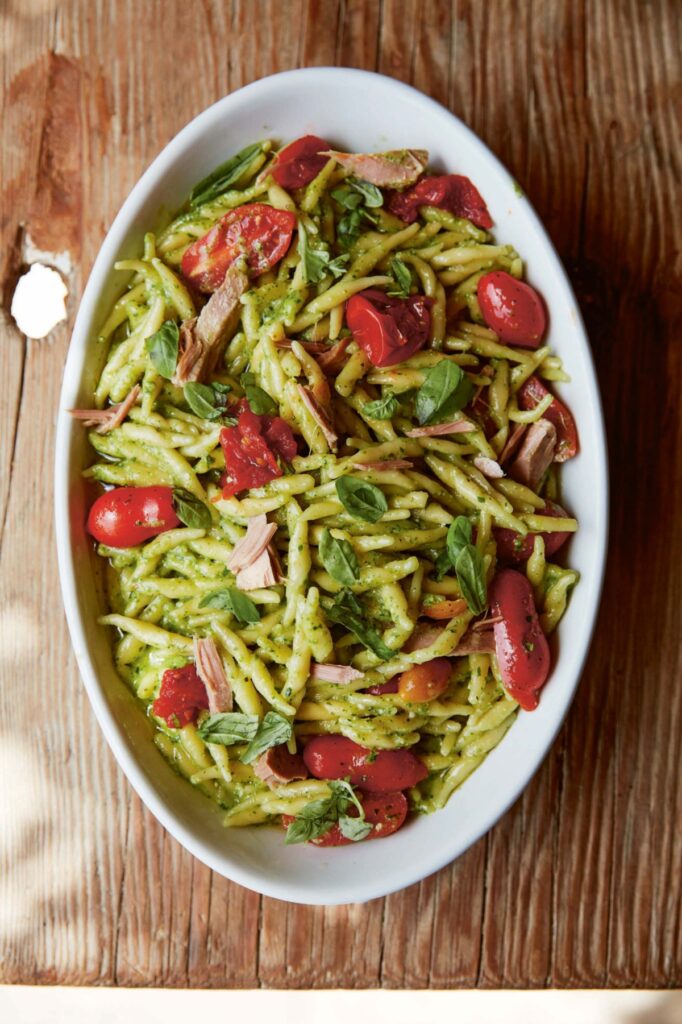The premise: English girl and Italian boy cooking in a restaurant somewhere in England fall in love. As Brexit looms they decamp to his home town in Sardinia. The boy-girl romance ultimately comes to an end but the girl remains in Sardinia, having lost her heart to the island, its people and their way of life.
Letitia Clark writes in a forthright, friendly voice, describing her introduction to the rustic, seasonal cuisine of Sardinia and her initiation into an Italian family that holds very firm notions about how things should be done in the kitchen. Working in restaurants, Clark had developed a disdain for fancy recipes and cheffy touches. The kind of food she wanted to make – delicious, simple, and made for sharing – is precisely what she finds within her new Sardinian family. Luca (the boyfriend)’s mother and grandmother cook with what is at hand, guided by tradition and memory. Meals are relaxed, lengthy affairs, not to be hurried and always to be enjoyed. Food is local and seasonal by default, ingredients valued in the way that only people who grow, gather and harvest them with their own toil truly appreciate.
Sardinian cuisine is frugal and based on vegetables, grains, olives and cheese, we learn. No-one diets or worries about eating, meals are inherently healthy and Sardinians are notably long-lived.
But Sardinian cooking relies on quality ingredients. As Clark writes “It is possible to make good food with average ingredients, if you have an armoury of spices and flavourings at your disposal, but the simplicity of Sardinian food allows for no such smoke and mirrors.”
I reviewed this book during COVID-19 lockdown so there was no hunting in gourmet stores for specialty ingredients. I had to skip the section on artichokes (one sad specimen in my local supermarket) and as much as I would have liked to, I couldn’t try bottarga – the salted fish roe that sounded so delicious in Clark’s recipes. But my pantry did contain the one ingredient Clark says cannot be substituted – best quality olive oil. And with canned San Marzano tomatoes and good tuna in oil, anchovies, garlic, lemons and some fresh herbs also at hand, I was able tackle a good range of recipes.
The book is divided into seven chapters: Aperitivo, Merenda, Verdure, Grano, Terra, Mare, Dolce e Bevande (roughly: nibbles to go with drinks, teatime snacks, vegetables, grains, meat, fish, sweets and drinks). Short essays such as how to cook pasta and prepare artichokes are informative and refreshingly down-to-earth – Clark admits preferring dry pasta to fresh and assures us that ‘al dente’ is more a matter of personal interpretation and preference than a gold standard for doneness. Snippets of history and local lore in side bars and recipe headnotes are well informed and fascinating, and food and location shots are stunning.
And the recipes themselves?
For Grilled Aubergines, Sapa, Ricotta Salata and Mint, Clark advises: “If you cannot find ricotta salata, feta is a good substitute. The same goes for the sapa – you can easily use date molasses instead. The important thing is to have something sweet and syrupy against something tangy and savoury.” I took a chance and used molasses from my baking shelf and even with that poor substitution, the balance of flavours was excellent. The dish was even better the next day when the eggplant had soaked up the tangy dressing.
Slow-cooked Courgettes with Mint, Chilli and Almonds, cooked as written, was another success. “I can taste almonds in courgettes. If you try this combination, maybe you will not think me completely mad,” Clark writes. And oddly, courgettes treated like this do taste like almonds.

A Kind of Italian Roast Chicken, slathered inside and out with a compound butter made with anchovies, garlic, rosemary and lemon, resulted in a moist and flavoursome bird with crisp, burnished skin and a pool of delicious, buttery juices.
At the same time I cooked Cardoncelli al Forno — roast mushrooms topped with garlic, parsley and olive oil — with portobellos replacing the Sardinian cardoncelli. As Clark promises, roasting intensifies the fungi’s flavour, and this is an easy and convenient dish to throw together if you already have something in the oven.

Pork Cooked in Milk with Cloves was a lovely recipe and dead simple to make. A piece of pork shoulder studded with a few cloves is slowly braised on the stove top in a bath of milk perfumed with lemon, garlic and bay leaf. The dish cooks itself, the milk breaking down into a savoury sauce, creamy and with a hint of caramel.
One of my favourite recipes was Fennel Gratin. Thin slices of fennel are briefly blanched then baked in a little cream flavoured with garlic, nutmeg and parmesan, with a sprinkling of fresh breadcrumbs on top. The result was luscious without being too rich, the fennel’s anise bite tamed just enough to let the background flavours shrine through.
From the Grano chapter I made Marcella Hazan’s simple tomato sauce (cooked with butter and an onion) to which Clark adds olive oil. Hazan’s recipe is rightfully famous but I approve of Clark’s tweak — the little bitterness from the olive oil lends a complexity I enjoyed. The sauce is intended for pasta but also makes an excellent topping for homemade pizza.
With my confidence growing and Clark’s gentle encouragement, I decided to tackle Trofie with Pesto, Tuna and Tomatoes. Trofie are little twisted pasta shapes made from a simple water and semolina dough. They are not difficult to master (Clark advises watching a Youtube video to learn the technique) but rolling trofie is a time-consuming task! It took two hours to turn the ball of dough into two cookie sheets covered in little squiggles. Impatient at first, I gradually settled into a meditative calm induced by the gentle rhythm of the process.
Dropped into a pot of boiling water, the trofie bob to the surface to announce they are done. Tossed with a homemade pesto, a can of best quality tuna and some little fresh tomatoes for sweetness, it’s a dish that rewards with flavour and texture, not to mention the satisfaction that comes with having made something so distinctive from scratch.

Some recipes are a tad impractical. In a post-publication blog entry, Clark apologizes for the fact that her recipe in Bitter Honey for Seadas (a cheese-filled pastry) is unachievable with anything other than fresh Sardinian cheese, after her brother attempts the recipe in the UK. My sister struggled with a recipe for Yogurt Cake that measures ingredients in “pots” and produced a dry and bland result. And I doubt that many of us will be roasting a whole suckling pig with foraged myrtle branches.
You will need to source some specialist ingredients, make some substitutions, or skip some recipes altogether. But for the most part Bitter Honey is full of recipes for simple, gorgeous food well within the reach of the home cook and ideally suited for sharing. It is also packed with clever tips and tricks from a professionally trained chef with a sound knowledge of ingredients and techniques.
Most importantly, as Clark writes in her blog, Bitter Honey is not only a book of recipes, but also a book about a place. And recipes, even sometimes impractical ones, help to tell the story of a place and its culture. Sardinia comes to life in Clark’s well-crafted prose. She is funny, compassionate, inquisitive and gifted with the ability to convey the particular charm of this unique Mediterranean island.
In these unprecedented and peculiar times, Bitter Honey is a marvellous escapist read, a pleasure to cook from, and a poignant reminder of how valuable are the times we spend with family and friends amid the conviviality of the table.


